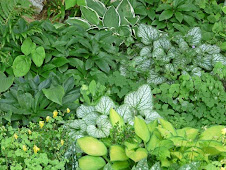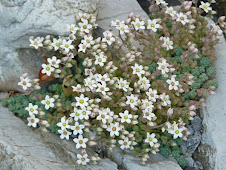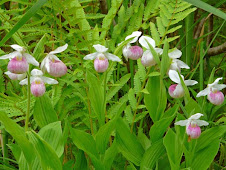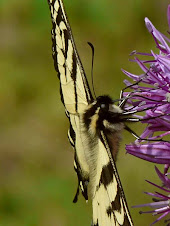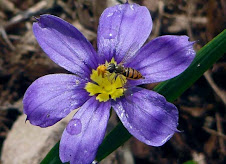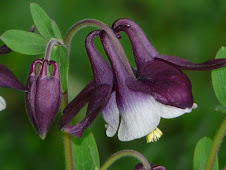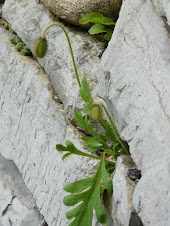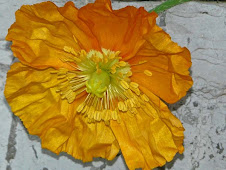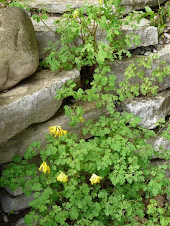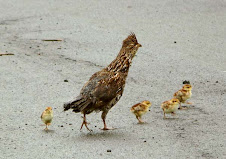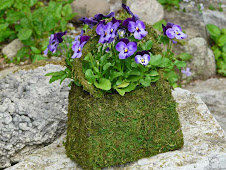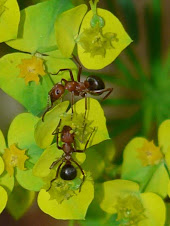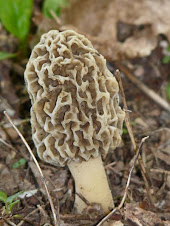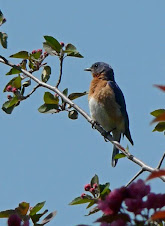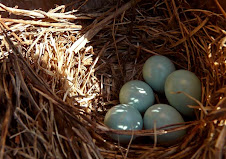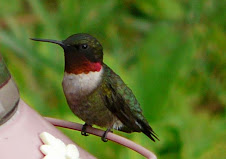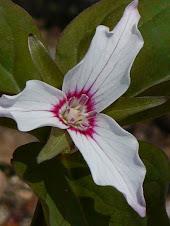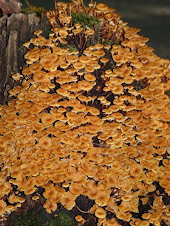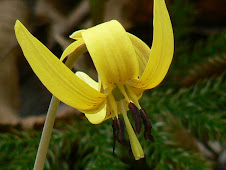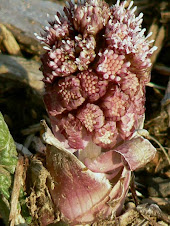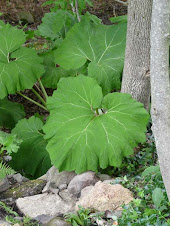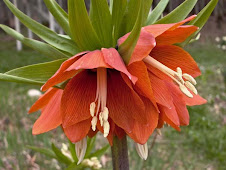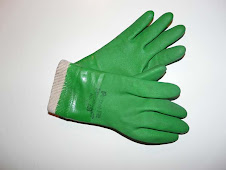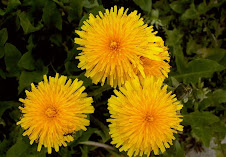Wednesday, April 29, 2009
Trilliums are blooming...
...in the woods. These amazing flowers are now decorating our woods and are such a welcomed sight. We are fortunate to have three different species in our woods, Trillium grandiflorum (White Trillium), Trillium erectum (Red Trillium aka Wake Robin) and Trillium undulatum (Painted Trillium). I have been told that thousands of Trillium used to grow in the woods near our house and when they bloomed the woods looked like they had floral carpets. However their beauty seemed to be the cause of their demise. People couldn't just look, they wanted to take them home and enjoy them too. But, when the Trillium are picked, the leaves and bloom which are all on one stem, leave nothing behind to create a new plant for the next Spring. So, once picked, the plant is gone forever. The floral carpets no longer exist in the Spring.We are so fortunate that the few we have on our property still exist.
Saturday, April 25, 2009
More things that I...
...never planted, but really enjoy. Some things in my gardens, and in the wood, meadow and hedgerows that I look forward are things that I have discovered. Things like wildflowers, mosses, mushrooms and lichens. All things that I delight in "discovering" each year, tiny things that amaze and amuse me. On a stump in the hedgerow, along the road, in front of our property, one thing that I wait for each year, is the return of a remarkable "village" of fuzzy foots. Fuzzy foot is the common name of Xeromphalina campanella mushroom. Another mushroom, an extremely tiny one (1/4" to 5/8"), that I enjoy "finding", is Splash Cup, Cyathus striatus. I put finding and discovering in quotes, because I basicly know where they are but, not exactly when they will be at peak. The Splash Cups look like tiny birds nest with eggs, but the "eggs" are actually spores. They grow on shredded cedar mulch that I put in the gardens to help control weeds. In the Ornamental Grass Garden I also mulch with shredded cedar and more "jewels" grow there, they are Beaked Earthstars, Geastrum pectinatum. Tomorrow some of the amazing mosses that adorn the wood and gardens.
Wednesday, April 22, 2009
The loveliest flower...
...I never grew. Oh, but I would love to be able to grow it. The first time I ever saw Meconopsis betonicifolia, Blue Himalayan Poppy was at Lynnwood Gardens near Philadelphia Pennsylvania, on the way to the Philadelphia Flower Show. The color is an amazing blue, so blue it almost took my breathe away, and the stamen are a wonderful contrasting orange. The next time I saw it growing was in Ogdensburg, New York, in a bog, along the St Lawrence River. The gardens belong to a friend, a Botanist, who spent many years trying and finally succeeding, in growing this magnificent Blossom. She told me that the seeds must be put in the freezer and removed and replaced, several times before attempting germination. The seeds, once they have germinated must be kept moist, never too damp and never too dry. When they are hardy enough to plant, the plant is the most important feature the first year. Which means, after the plant is strong and begins to form a bud, the bud most be removed. Removed so the plant can become heathly and strong. The following year, if the plant survives the winter, then you can let the bud form and become a bloom. Like I said, the prettiest flower I never grew.
Tuesday, April 21, 2009
Recently, I was asked...
...why I include Genus and Species when referring to specific Flora and/or Fauna. It is because Common Names are just that. Common to a specific area or group of people. For example, a favorite wild or woodland flower is Erythronium americanum, aka. Trout Lily, Adder's Tongue or Dog Tooth Violet. It has been called Trout Lily because its leaves are speckled like a trout, it blooms at trout season and is in the Lily Family. Some call it Adder's Tongue because its flower reminds them of an adder serpent. Yet still others know it as Dog Tooth Violet because its root looks like a dog's tooth, and perhaps seems similar to a yellow violet. I suppose it isn't any different than all the nicknames we have for each other.
Robin Wall Kimmerer wrote in her book Gathering Moss, "It is a sign of respect to call a being by its name, and a sign of disrespect to ignore it. Words and names are the ways we humans build relationship, not only with each other, but also with plants." I fully agree.
Robin Wall Kimmerer wrote in her book Gathering Moss, "It is a sign of respect to call a being by its name, and a sign of disrespect to ignore it. Words and names are the ways we humans build relationship, not only with each other, but also with plants." I fully agree.
Monday, April 20, 2009
Lots of Activitity...
...in the gardens, the wood, the ponds, and the meadow. While photographing wildflowers in our wood, I spied the first (Bombylius spp.) Large Bee Fly of the season. They look a bit like a mini Hummingbird, as does the Hummingbird Clear Wing Moth. It was hovering above a Hepatica blossom. Both a (Artogeia rapae) Cabbage White and a (Nymphalis antiopa) Mourning Cloak Butterfly have fluttered through the yard. On the pond the (Rana sylvatica) Wood Frogs have begun their mating, which sometimes begins before all the ice has melted. Their croaking and that of the (Hyla crucifer) Spring Peepers are sounds of the night, that are anixously awaited and appreciate. Many migratory birds are visiting the feeders and a (Buteo jamaicensis) Red Tailed Hawk is soaring over the meadow. Each a joyful sight and sound, for which I am most grateful.
Saturday, April 18, 2009
Lovely and Unique...
...things are blooming in the gardens. Among the lovely are Helleborus orientalis, Lenten Rose, it is in full bloom (just missed Lent and Easter). Another that is blooming, is Astilboides tabularis, a very unique blossom. I don't know the common name or if there even is one. I purchased the plant at White Flower Farms in Litchfield, Connecticut several years ago, while on a garden club tour of New England Nurseries. The first glimpse of the enormous leaves and I knew I wanted that plant . The genus contains a single species, and what a species it is!!! It is native to Northern China, it prefers partial shade, but I have it growing in full sun. The plant height is about 3 feet and each leave is in excess of 24 inches. It is invasive but, not too difficult to keep under control. In the garden it is truly a show stopper.
Friday, April 17, 2009
Playing in the Mud...
...isn,t just for kids. Yesterday a gardening friend and I took a "hypertufa" class and played in the mud. We both made a container that is made from equal parts of portland cement and "Promix".
The Promix is a combination of chopped sphagnum moss, perlite and sand. The cement and potting mix are combined with water, until it is a smooth consistent mix and will make into "mud balls" easily, (it is like making pie dough). We had a mold which was made of styrafoam and molded the "mud" into the form. The shape is actually octagonal, but looks like a large rectangle with pushed in corners. It is about 20" by 14" and about 10" deep. It will be ready for Spring planting, but takes about 21 days to cure. The plants used in hypertufas are usually apline (rock garden) plants. I did a post on this last month. Both my gardening friend and I agreed that it was wonderful day and great to "play in the mud" again. Once the container is "cured" and planted I shall post a photo.
The Promix is a combination of chopped sphagnum moss, perlite and sand. The cement and potting mix are combined with water, until it is a smooth consistent mix and will make into "mud balls" easily, (it is like making pie dough). We had a mold which was made of styrafoam and molded the "mud" into the form. The shape is actually octagonal, but looks like a large rectangle with pushed in corners. It is about 20" by 14" and about 10" deep. It will be ready for Spring planting, but takes about 21 days to cure. The plants used in hypertufas are usually apline (rock garden) plants. I did a post on this last month. Both my gardening friend and I agreed that it was wonderful day and great to "play in the mud" again. Once the container is "cured" and planted I shall post a photo.
Subscribe to:
Posts (Atom)
The Deerly Beloved

Garden Flowers-Yum!!!


